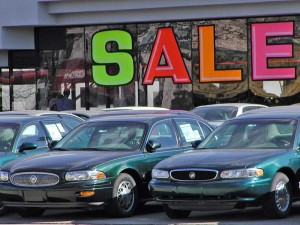A sharp rise in consumer confidence – which helped drive the Dow Jones Industrial Average to a 13,000 close for the first time since 2008 – is likely to also help push the auto industry towards a faster recovery than initially expected.
Consumer confidence, which is also one of the key indicators for car sales, remained strong in February due to a record number of consumers who were aware of ongoing increases in jobs, says University of Michigan economist Richard Curtin, director of the Thomson Reuters/University of Michigan Surveys of Consumers.
A separate study further buoyed prospects for the auto industry by showing that lenders continue freeing up more cash for potential buyers.
February marked the sixth consecutive month of gains in the Sentiment Index as consumers became more positive about prospects for the economy. But there was a downside, researchers warned.
“Unfortunately, too few consumers have benefited from the recent job gains to alter their otherwise grim evaluations of their own finances,” said Curtin.
The highest proportion of consumers in the long history of the surveys spontaneously reported hearing about recent employment gains. When asked about prospective changes in unemployment, consumers were also more optimistic, with more consumers expecting declines in the jobless rate than at any time since 2004.
The only thing holding back the recovery seems to be personal finances – which the survey found consumers still describing as “dismal.” More households reported recent income declines than increases, for the 41st consecutive month.
“Consumers have shrugged off concerns about rising gas prices, the European crisis, and election year politics, preferring to focus on the favorable impact of job growth,” said Curtin. “A potential threat is that consumers expect too much too soon. Improved job prospects may entice many more people to seek work, easily outstripping the number of new jobs created,” Curtin said.
Meanwhile, Experian Automotive reports automotive loan market showed continued improvement, with interest rates for new and used vehicle loans reaching the lowest levels since 2008, according to its quarterly automotive credit analysis for the fourth quarter of 2011.
Average credit scores for new and used vehicle loans also dropped as the percentage of loans to customers with nonprime, subprime or deep subprime credit scores increased, and lenders increased their willingness to make loans between six and seven years long.
“The improved automotive lending market is good news for consumers in the market to buy a vehicle,” said Melinda Zabritski, director of automotive lending at Experian Automotive. “The confluence of low interest rates, longer loan terms and an increase in loans outside of prime provide a great opportunity for more people to find a vehicle that suits their needs,” she said.
Consumers also continued to do a better job of repaying loans in Q4 2011, as loan delinquencies fell. The 30-day delinquency rate fell 6.57% from Q4 2010 to Q4 2011 (2.98% to 2.79%). The 60-day delinquency rate fell 9.51% from 0.79% in Q4 2010 to 0.72% in Q4 2011.
Another positive sign for the lending market is that the overall dollar volume of loans at risk dropped to $18.5 billion, a $1.862 billion decline from Q4 2010. Meanwhile, the total volume of open loans rose by $23.9 billion in Q4 2011 to $658 billion.
“Lenders are clearly on much more solid ground than they were two or three years ago,” said Zabritski. “With delinquencies and total dollar volume at risk down, lenders have been able to adopt more aggressive strategies. This tends to benefit everyone, from lenders to automotive retailers to the end consumer. With more lenders aggressively competing for business, it’s a great time for consumers to buy or finance a vehicle.”
The latest studies could lead automotive industry analysts to revise their forecasts for the year. Most had been anticipating sales of just under 14 million for 2012 but several key observers have been hinting they might revise their figures upward to 14 million – generally considered the point of an industry recovery – or even higher.

